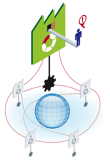The Benefits of Inbound Pull in Modern Logistics
Brian Hoey - December 13, 2018

 Let’s pretend that you and a friend are both mixologists at an upscale cocktail lounge. On weekends, there tends to be a rush of patrons late in the evening who ask for drinks faster than you can produce them. As a supply chain or logistics manager in real life, in this scenario you might be tempted to suggest that you and your fellow bartender start creating a buffer stock of drinks before the big rush, so that people can receive their drinks as soon as they order them. Unfortunately, you can’t really know what drinks people will order in advance (to say nothing of the fact that the ice will melt), so creating a buffer stock is impractical. You can, however, do some prep in advance, like preparing garnishes and simple syrup. When the rush comes, you’re still slammed, but you’re able to create drinks more efficiently.
Let’s pretend that you and a friend are both mixologists at an upscale cocktail lounge. On weekends, there tends to be a rush of patrons late in the evening who ask for drinks faster than you can produce them. As a supply chain or logistics manager in real life, in this scenario you might be tempted to suggest that you and your fellow bartender start creating a buffer stock of drinks before the big rush, so that people can receive their drinks as soon as they order them. Unfortunately, you can’t really know what drinks people will order in advance (to say nothing of the fact that the ice will melt), so creating a buffer stock is impractical. You can, however, do some prep in advance, like preparing garnishes and simple syrup. When the rush comes, you’re still slammed, but you’re able to create drinks more efficiently.
This example should illustrate two things: one, that bartending is hard work; and two, that finding the balance between push and pull strategies can be complicated, delicate work. No business can perfectly calculate all demand in advance and simply prepare their goods on a set schedule ahead of time, just as no business can wait until the customer is standing at the cash register to put a supply chain strategy into place. For many supply chains, a primarily push-based strategy remains the norm, but what would happen if those in the industry thought a little more like our pair of mixologists?
Push vs. Pull
Okay, let’s back up for a second. In the paragraph above, we alluded to push and pull models for supply chain and logistics strategy, subtly suggesting that an increased emphasis on pull models could become a value driver for businesses that adopt them. But before we get into why that my be the case, we’re going to offer a quick refresher on the difference between push and pull. In push-based models, businesses don’t wait for real demand to materialize before they source, manufacture, distribute, or ship their products. Instead, they estimate demand and plan (at any level of the supply chain) to meet that demand by “pushing” their products through the value stream toward the consumers. In pull systems, the opposite is true. Businesses wait, to the extent that they’re able, for real demand to materialize before letting their goods be “pulled” upstream. This concept is closely associated with popular ideas like just-in-time deliveries and lean supply chain planning. Pull models often make more sense for businesses that offer a high degree of customization (like our bartenders above, for instance), but in point of fact almost all businesses utilize a combination of the two, pushing their products through a certain number of touchpoints on the value chain and letting them be pulled the rest of the way.
The Benefits of Inbound Pull
Now, the all important question: so what? If all businesses utilize some of both system, why should you consider it a priority to shift towards one or the other? Simply put, an increased emphasis on pull-based planning can help to reduce the need for large buffer stock and create more efficient, synergistic production and transport workflows. How? By giving disparate points on the value chain enough visibility and insight into one another’s operations to maintain planning flexibility. Let’s say, for instance, that your industry’s real demand levels are fairly predictable year over year, and a push-based production workflow makes the most sense. You could still implement pull-based strategies at the logistics level. Instead of scheduling transports in advance and adhering to rigid timetables for moving parts or finished goods, you could wait to transport your stock from one manufacturing facility to another until necessary parts from a third facility are ready to be shipped, so that the final product can be assembled without a long, unnecessary lead time spent waiting for all of the parts to arrive.
In this way, you might be able to avoid less-then-full truckloads and costly inventory usage. By the same token, you could leverage these pull-based principals in order to choose the optimal shipping times based on factors like price fluctuations and the availability of direct routes. In this scenario, you essentially capitalize on changing circumstances simply by reducing the rigidity of your transport logistics plans. Instead of determining a plan and hoping the market plays along, you let the market guide your planning, allowing subtle signals from within and without your own supply stream operations to present a fluid path for more responsive, synergistic operations.
Getting in Sync
If we think back to our two mixologists, we can see how the idea of inbound pull in modern logistics represents a delicate balancing act. Real demand levels from the patrons determines the actions of each bartender, but they’re still able to be proactive rather than reactive. They might divide up different tasks between the two of them, timing things carefully in order to ensure that ingredients are ready at the precise moment they’re needed. There is added value here in the form of smooth, efficient production and distribution (of drinks), but there are also a number of challenges. Without effective channels of communication open, for instance, plans can quickly fall apart due to poor coordination. By the same logic, data or decision-making silos can make it difficult or impossible to synchronize your plans with real demand levels and with the existing needs of your production and logistics plans.
This, essentially, represents the challenge that businesses need to overcome in order to transition to an inbound pull model. Outdated information, poor communication, and over-reliance on demand forecasts effectively force businesses to rely on a push model even when waiting for the “pull” would present more opportunities to bolster efficiency. For businesses that can overcome these hurdles, inbound pull represents a potentially significant value added proposition.
LATEST POSTS
- Understand Why Production Planning Needs Specialized Solutions
- Understand Circular Economy in The Manufacturing Industry
- How Can Industry 4.0 IT Integration Be Achieved Smoothly?
- The Significance of Order Sequencing in Discrete Manufacturing
- How to improve your Supply Chain Management: The Power of Control Towers



